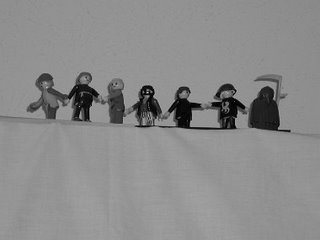Give a hoot! Read a book as belonging to an essential category!University of Minnesota English professor David Treuer, an Ojibwe Native American, is publishing two books which attack traditional ways of reading literature by or about Native Americans (
New York Times article). Prof. Treuer is annoyed that academics read both kinds of writing as ethnography rather than literature. Native American writing and writing about Native Americans should take its place, he argues, alongside all other literature and should be read as such, rather than as a sociological document or piece of fieldwork data. This argument has a somewhat musty odor since it relies on the idea that we should read documents in particular, regimented ways; I’m not interested in getting into a theoretical citation contest here, but my experience in anthropology (the home discipline of ethnography) has been that everyone reads novels as ethnographies and ethnographies as novels or any other permutation of the two, whatever is most interesting. Insisting that literature be read as literature assigns essential and enduring qualities to literature as an object and is thus rigid and unreflexive. Dr. Treuer’s ideas are interesting and welcome and certainly persuasive (I am no expert on the scholarship of Native literature, so I have reason not to believe that it generally gets read as ethnography), but I find it more interesting as a description than as a manifesto. Certainly, he should draw attention to how the writings get read, but trying to re-assign them to a more correct category ignores their existence as a object in full contact with academic and popular readings. It’s also puzzling that he spends time criticizing Louise Erdrich for screwing up important details of Ojibwe language and regional dialect; if we are supposed to read her writing as novel rather than ethnography, imagination rather than empirical document, why should we hold her to such exacting standards?
REVIEW ROUNDUPPulseAs boring and un-frightening as a horror film could possibly be. Even the angular charms of
Veronica Mars’s Kristen Bell can’t save this badly-paced, dull tale of evil ghosts who fax themselves to their unwitting victims. Led by a pasty white naked Sir Ben Kingsley, these ghosts travel through cellphones and IM to sap the life from their victims, leaving them deadened and without a will to live (much like the movie does to its viewers). As
The Onion pointed out, the riot-proof apartments of downtown Romania don’t stand in for Ohio very well, especially since everything is covered with a thick layer of blue Final Cut filters. When I went to the bathroom after this movie a man with huge sideburns and his little son told me, unsolicited, “Whatever you do, don’t see
Pulse.” Too late!
The DescentIt occurs to me that the monsters in this movie actually look almost exactly like the ghosts from
Pulse, but have the advantage of being so scary that I had to have major heart surgery during the credits.
The Descent is basically
The Cave sans Piper Perabo and plus about a zillion times more directorial talent and nerve-wracking cinematography. Six no-name British or possibly Norweigan actresses enter a cave complex bearing climbing rope and emotional baggage and OH SHIT CAVE MONSTERS BITING EVERYONE’S FACE OFF OH SHIT A PIT OF CONGEALED BLOOD EVERYONE’S DEAD OH MY GOD! Highly recommended.
Miami ViceI thought this was the big-screen version of
Dr. Katz, but it turns out it’s Miami VICE, not ADVICE. That’s a little psychiatry/media humor just for you, no charge this time! This movie was very good but was so plotty that the actors didn’t have much room to move – Gong Li was the exception, delivering a long slow reveal of an interesting character and somehow seamlessly going from sharp-faced shrew to beautiful movie star without any obvious changes. You know the setup for the movie so I won’t summarize, but it’s definitely fun and worth seeing.
Talladega NightsThis was a pleasant surprise: Sacha Baron Cohen’s evil French NASCAR driver steals the entire movie, but even the scenes he’s not in bore a relatively light touch and were actually funny, unlike
Anchorman and
Elf. Watch for John C Reilly’s nuanced performance as imbecilic sidekick Cal Naughton (seriously).


